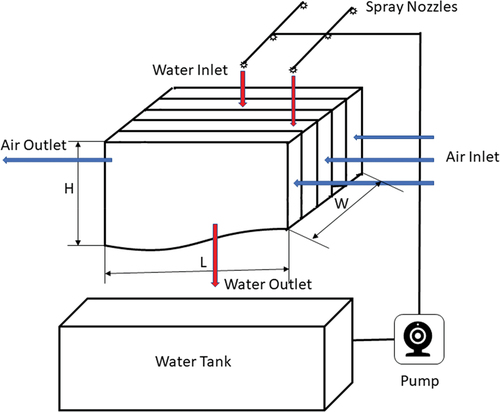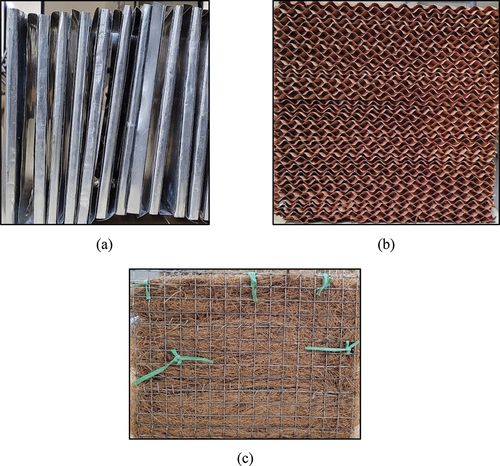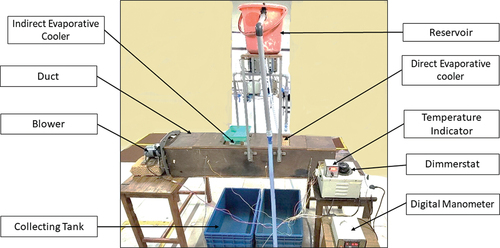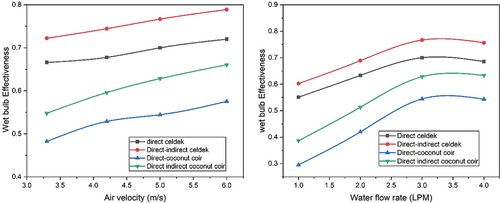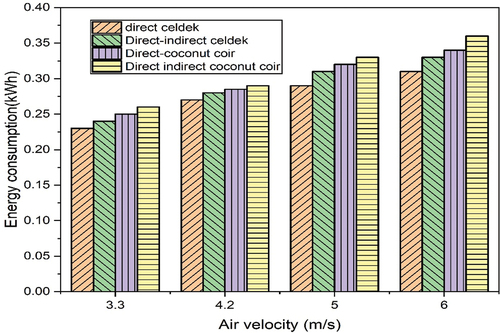 ?Mathematical formulae have been encoded as MathML and are displayed in this HTML version using MathJax in order to improve their display. Uncheck the box to turn MathJax off. This feature requires Javascript. Click on a formula to zoom.
?Mathematical formulae have been encoded as MathML and are displayed in this HTML version using MathJax in order to improve their display. Uncheck the box to turn MathJax off. This feature requires Javascript. Click on a formula to zoom.ABSTRACT
To overcome the drawbacks of a single-stage evaporative cooler, an indirect-direct type evaporative cooler was proposed and fabricated. An alternative arrangement of mild steel plates wherein unmixed heat transfer occurs between air and water to form an indirect evaporative cooler. This is followed by a packing arrangement made of biomass-based coconut coir that forms a direct evaporative cooler. Experiments were conducted by varying the air and water flow rates, and the performance of the coconut coir was compared with that of a commercially available celdek packing. Experimental results indicated that a combination of an indirect-direct evaporative cooler helped cool air without an appreciable increase in air-specific humidity. The performance of the coconut coir is slightly lower than that of the Celdek coir in terms of the drop in DBT and wet-bulb effectiveness. A maximum wet bulb effectiveness of 0.78 and 0.63 was achieved for the celdek and coconut coir packings, respectively. The maximum performance was attained at an air velocity of 6 m/s and a water flow rate of 3 LPM. Owing to the different advantages of coconut coir over celdek packings, it is recommended to use coconut coir as an alternative packing in indirect-direct evaporative coolers.
1. Introduction
The temperature of the environment is rising day by day as a result of global warming. The indoor air temperature and relative humidity are critical factors in determining the human comfort zone. The term ‘comfortable zone’ refers to a space with a temperature of 25°C at room temperature and relative humidity of 55% according to ASHRAE standards. The use of mechanical vapour compression-centred air-conditioning systems consumes more power, and the use of refrigerants contributes to environmental pollution (Tejero-González and Franco-Salas Citation2021). To overcome these problems, evaporative cooling has been adopted recently because it is energy efficient. The advantage of using the evaporative cooling technique is that it uses water as a refrigerant to cool air, making it environmentally friendly. When warm air comes in contact with water, it loses its density, as its ability to contain moisture increases with temperature. Hence, water evaporates by taking energy from the air for evaporation. This cools the air simultaneously, making it more humid. This evaporative cooler is known as a direct evaporative cooler. The critical design parameters influencing the process include the pad material, dimensions, and configurations. The operating parameters include air and water flow characteristics, surrounding temperature, and humidity conditions. Several researchers have conducted comprehensive experiments using Celdek, a commercially available packing material, and have achieved good cooling performance (Jain and Hindoliya Citation2011; Malli et al. Citation2011; Mujahid Rafique et al. Citation2015; Xu, Xie, and Xiao Citation2017). The cooling efficiency was on the order of 50–85%, with relative humidity (RH) reaching nearly the saturation condition. Even though the single-stage evaporative cooling mechanism offers advantages such as cost-effectiveness and low maintenance, it has several limitations, such as excessive water consumption, poor suitability for hot and humid climates, low humidification efficiency, and limited temperature drop. To enhance the performance of coolers, researchers have modified the basic design by adding more stages.
Two-stage evaporative cooling units consisting of an indirect evaporative cooling (IDEC) and a direct evaporative cooling unit (DEC) are used by some of the investigators (Heidarinejad et al. Citation2009). They revealed that this system offers an effectiveness of about 55 to 61%. The studies where two and three-stage evaporative cooling units were incorporated, and the investigators found that the humidification efficiency improved by 10% for the three-stage unit (Al-Juwayhel et al. Citation2004). Zamen, Soufari and Amidpour (Citation2011) studied multi-stage humidification, dehumidification (HDH), and desalination units. The multi-stage showed better performance than the single-stage in terms of the drop in the temperature values.
Even though the cooling performance increases in multi-stage systems, it also has drawbacks such as increased water consumption, higher pressure drops, and exit air near the saturation state. Highly humid air is prone to microbial growth and may cause respiratory infections in humans. Hence, the exit humidity must be maintained in line with the thermal comfort conditions, keeping the exit temperature at its lowest as according to ASHRAE 55 standards (Salins et al. Citation2023). Because both are interrelated, this is difficult to achieve in the case of simple single-stage or multi-stage direct evaporative coolers. Hence, some modifications to the basic principle of direct evaporative cooling have been focused on for several years. Few studies have been conducted worldwide on this topic.
Tripathi and Kumar (Citation2023) used an energy-efficient and eco friendly indirect cooler consisting of an wet channel to cool the air using solar energy in a cross-flow heat exchanger. The low temperature water is used to cool air stream without increasing the exit humidity. They observed the cooling capacity in the range of 124.3 to 1032 W and the wet bulb efficiency of 59–90%. In order to reduce pumping energy required for pumping water in an Indirect evaporative cooler Shi et al. (Citation2022) developed a system consisting of a porous layer in the secondary air channel. The result showed that supply air temperature could be maintained for 2105 seconds without the requirement of spray water that reduced 95% of operating time. In addition, COP was also increased by 117.5%. E De Antonellis et al. (Citation2016) carried out comprehensive tests on an indirect evaporative cooler under varied operating and nozzle conditions. Results concluded that performance of an indirect evaporative cooler is strongly dependent on the water flow rate and is least dependent on the nozzle size and number of nozzles. Counter flow performed better than the cross-flow type with the wet bulb effectiveness ranging from 50–85%. Nie et al. (Citation2018) developed an indirect flash evaporative cooler combined with ultrasonic atomiser for building ventilation. The exit air is oversaturated by using ultrasonic atomiser which in turn is used to cool the incoming air. Temperature recovery ratio was in between 102–146% and latent heat recovery in between 42–56%. The heat recovery efficacy was in the range of 61–71%.
Zhou et al. (Citation2021) developed an experimental setup for a two-stage indirect thermoelectrically assisted direct evaporative cooler. The air is cooled in the direct evaporative cooler and then passed over a thermo-electrically assisted system to further cool it. The results revealed better cooling efficiency over a single stage. Farmahini Farahani et al. (Citation2010) constructed a two-stage system consisting of an indirect evaporative cooling and nocturnal radiative cooling system using three different models. All three models performed well and provided both the necessary and required cooling. It was concluded that hybrid systems are much more effective than indirect evaporative coolers (IEC) alone. Heidarinejad and Moshari (Citation2015) determined the effect of spray water temperature variation in a two-stage evaporative cooler. The results showed that the two-stage direct/indirect had 50% higher wet bulb effectiveness than the single-stage while having the same inlet parameters. Eldessouky (Citation2004) analysed the performance of a two-stage direct indirect evaporative cooler using high-density polythene as the filler material. Results revealed that the efficiency of the direct indirect cooler varied over the range of 90–120%, indicating that the dry bulb temperature of outlet air was lower than the wet-bulb temperature of the intake air. The performance of the composite bio desiccant using a nanofluid cooling in a plate-type heat exchanger was studied by Kumar et al. (Citation2023). Alklaibi (Citation2015) conducted an experimental investigation of an internal two-stage evaporative cooler using the Maisotsenko cycle. The internal two-stage evaporative cooler had better system efficiency than the direct evaporative cooler unit.
Although several studies have been conducted using a combination of indirect and direct evaporative coolers, the increase in performance has not been satisfactory. Further, owing to the addition of various critical components, the initial investment also increased. Hence, to make them cost-effective, a simple mechanism that can reduce the exit temperature to a considerable value without appreciably increasing air humidity is required. Hence, there is vast scope for improving the design of direct evaporative coolers.
Furthermore, most packing materials used by researchers are celdek packing materials, which are uneconomical, costly, and unavailable in rural regions. To make evaporative coolers environmentally friendly, biomass-based filling materials have been in focus for the last 4 to 5 years. Several researchers have conducted experiments using different biomass-based packing materials in single-stage direct-evaporative coolers.
Abohorlu et al. (Citation2019) used eucalyptus fibres as an alternative packing material for evaporative cooling. Experiments were conducted in a wind tunnel. They noticed a maximum cooling efficiency of 71% when the air flow rate was maintained at 0.1 m/s. Gunhan, Demir and Yagcioglu (Citation2007) evaluated the sustainability of pad materials used as cooling pads for direct evaporative cooling. Here, pumice stone (coarse), pumice stone (fine), and volcanic tuff were used as the cooling pad materials. Their performance was compared with cellulose pad (Celdek) packing and was found to be marginally less than that of Celdek.
Jain and Hindoliya (Citation2011) used palash, khus fibres and Aspen as the packing material in a direct evaporative cooling set up. Palash gave a higher cooling efficiency over aspen and khus fibres with the maximum values observed as 81%. Naturally available materials such as activated carbon foam and luffe fibres were tested as an alternate packing material for evaporative cooling undertaken by Abd Aziz et al. (Citation2018). Results showed that carbon fibre foam has higher temperature depression and higher cooling efficiency than luffa fibres. For the tested conditions, they claimed that activated carbon pads have better foam structure and high wettability than luffa. Feasibility of using jute fibre, palm fibre and wooden charcoal as a packing material was tested by Ndukwu et al. (Citation2022) in the Nigerian climate. Jute fibres showed highest wet bulb effectiveness of 78% where as palm showed the lowest. They also concluded that cooler performance diminishes at higher humidity conditions. Suranjan Salins, Reddy, and Kumar (Citation2021) constructed a direct-type evaporative cooler unit made of locally available cooling pad materials. Coconut coir and wood shavings were used as the different materials. The results revealed that wood shaving performed better than coconut coir but less than celdek packing. Franco, Valera and Peña (Citation2014) used a wind tunnel to experiment with evaporative cooling using plastic- and cellulose-based packing of varying thicknesses. Plastic packing gave a pressure drop of 11.05 Pa and a humidification efficiency of 51.27%. Cellulose pads gave a maximum humidification efficiency of 80%, higher than plastic-based packing. Ahmed et al. (Citation2011) evaluated the performance of three types of packing: wood slices, straw pads, and cellulose. The packing density varied with changes in the packing dimensions. The results indicated that wood slice packing and cellulose packing provided higher humidification, and straw packing provided the least humidification performance.
From these studies, it can be seen that a few researchers have used biomass packing as the filling material for direct evaporative coolers. They found that the cooling efficiency was marginally lower than that of the commercially available celdek packing. Very few researchers have used biomass-based packing in indirect-direct heat exchangers. Furthermore, to the best of the author’s knowledge, the use of coconut coir as a filling material has not been comprehensively studied as an alternative packing material for evaporative coolers. The influence of coconut coir on the performance of an indirect-direct combination has not been explored by investigators. An indirect-direct evaporative cooler was fabricated to bridge these gaps. A series of mild sheet plates were joined together such that air and water moved in perpendicular directions while exchanging energy, forming an indirect heat exchanger. Air can pass through the coconut coir packing, where it interacts with water and articulates the direct evaporative cooler. Experiments were conducted by varying the air velocity and water flow rate, and the results were compared with those of neat Celdek packing to justify the possibility of using coconut coir as an alternative packing material.
The use of an indirect-direct cooler can limit the relative humidity of the air at the inlet to the room and helps to maintain it at a lower value. Furthermore, even though coconut coir shows slightly reduced performance compared to commercially used celdek, owing to its advantages such as biodegradability, easy availability at free of cost, easy replacement, and lower maintenance, it is an alternative packing material for evaporative cooling. As a sustainable technique adopted to cool rooms, it also fulfils UNSDGs, specifically SDG 7 and SDG 11. As they are sustainable, they can reduce the cooling loads of conventional air conditioners. Hence, it also helps to limit carbon footprints and keep the environment free from polluting.
2. Methodology
2.1. Working principle
The proposed system consisted of two segments: an indirect heat exchanger and a direct evaporative cooler. A series of mild steel plates were soldered together to form two passages: one for air and the other for water. The two fluids pass through the gap between the plates, during which air loses its sensible heat to water. As a result, the air temperature dropped without a change in the specific humidity. Later, the same air is subjected to the direct evaporator, where water is sprayed from the top of the packing through the nozzles, and air-water interaction takes place by which water evaporates by taking the sensible heat from the air; hence, the air temperature decreases with a simultaneous increase in the humidity. . illustrates the principle of an indirect-direct evaporative cooler.
2.2. Mathematical equations
Overall wet bulb effectiveness: The wet bulb effectiveness is the ratio of the temperature difference between the vent and outlet DBT to the temperature difference between the inlet air DBT and the wet-bulb temperature (WBT) of the inlet air.
a) Wet bulb effectiveness () is given by
where and
are the dry-bulb temperatures of air at the inlet and outlet of the unit, respectively, and
is the wet-bulb temperature of air at the inlet of the unit.
b) Cooling effect (): The cooling effect provides the magnitude of the energy removed from the air to reduce its temperature.
where ma is the mass flow rate of air (kg/s), is the specific heat capacity (J/kgK), and ΔT is the change in the temperature at the inlet and outlet of the system.
It is also given by
ΔT is the temperature difference between the inlet and exit of the indirect heat exchanger for air, and Δh is the difference in the enthalpy values at the inlet and outlet sections of the direct evaporative cooler.
c) Evaporation rate (): Evaporation rate is given by
where is the mass flow rate of air and
and
are the specific humidities at the inlet and outlet of the direct evaporative cooler, respectively.
2.3. Experimental test rig
For constructing the IEC (Indirect evaporative cooler), mild steel sheets with dimensions 250 mm × 250 mm and a thickness of 0.5 mm have been chosen. Sheets are soldered so that on the top side, they are closed, and on the other side, they are open, allowing air to pass through. Each plate is kept between two other sets of plates whose side faces are closed and open at the top to allow the cold water to flow from top to bottom. Likewise, 24 passages were soldered together, as shown in , constituting the IEC.
Further, a wrought iron meshed structure with dimensions of 250 mm × 250 mm × 7.5 mm was fabricated. Initially, a cellular celdek packing with appropriate dimensions was placed inside the meshed structure, as shown in , which acts as a direct evaporative cooler. After the initial experiments, this was replaced by a set of coconut coir with the same wettability values as that of Celdek, was used as the direct evaporative cooler, as shown in . Wettability is defined as the ratio of the surface area available for the fluid interaction to the volume. Based on the surface area and volume considered, the Celdek packing’s wettability is found to be 632 m2/m3 Kumar et al. (Citation2022). For the coconut coir as the volume is constant, required mass to have an wettability of 632 m2/m3 has been calculated and inserted into the mesh structure.
The two packings were placed inside a duct with a cross-section of 270 mm × 270 mm and a length of 1500 mm. At one end of the duct, a blower is placed with a capacity of 90 W, which blows air initially through the IEC, followed by a direct evaporative cooler (DEC). K-type thermocouples were placed at the beginning (before the IEC), after the IEC, and after the DEC to measure the corresponding temperatures. Similarly, RH values at the respective positions were noted using hygrometers. The air velocity at the beginning and after passing through the packing was recorded by the anemometers. Water can flow from an overhead tank onto each packing, controlled by a gate valve. Water was initially collected in a tray and then dripped uniformly onto the individual packing through the small holes engraved in each packing to ensure uniform water distribution throughout the packing surface. After the interaction, water will be collected in the collecting tank and pumped to the overhead tank. Pressure tapings were taken at the inlet and exit of the duct and were connected to the digital manometer, which read the pressure head difference between the pads. . shows a photograph of the complete setup. lists the instruments and their specifications.
Table 1. Instrument specification; Kumar et al.(Citation2023).
2.4. Experimental procedure
Initially, experiments were conducted using celdek packing. Entry air conditions such as air temperature is maintained at 28 ºC and entry RH is maintained at 60%. The blower rpm was adjusted such that the inlet air velocity was maintained at the required value, as listed in . The gate valve is adjusted so water falls on the indirect pads and the Celdek packing with the set flow rate. Once the above steady-state conditions of air and water were reached, the exit temperatures, RH values, and pressure head values were recorded. Experiments were conducted by varying the air velocity and water flow rate, as listed in . The packing structure was replaced by a coconut coir, and the experiments were repeated. The performance parameters are calculated using the above data, as presented in Section 2.2, and are discussed in Section 3.
Table 2. Variation of operating conditions.
2.5. Uncertainty analysis
Uncertainty analysis evaluates the uncertainty of dependent performance parameters. They are calculated analytically based on the error propagated while measuring the independent variables.
If X1, X2, .Xn is the independent variable, y1, y2 … yn are the uncertainty intervals, and U is the function. The total uncertainty of the output variable was calculated as follows:
In the present case, errors during the measurement of DBT, relative humidity, air velocity, and energy consumed were used; hence, the uncertainty of the dependent variables evaporation rate and wet-bulb effectiveness were calculated and are shown in .
Table 3. Error values for output variables.
3. Results and discussion
3.1. Exit temperature
shows the ratio of the outlet DBT to the inlet DBT values for various operating conditions. It also narrates the comparison of ratios for the chosen materials, celdek and coconut coir packings, for only direct and indirect packings. For all cases studied, as the air velocity increased, the ratio decreased. This means that for a higher air velocity, a higher amount of water evaporates by taking more energy from the air, thereby reducing the exit air temperature. When the outlet temperature was reduced, the ratio decreased for a fixed inlet air temperature, which is visible in . Inlet air velocities that are too high will exhibit very low exit air velocities, which may be inappropriate for thermal comfort conditions and may lie outside the range specified by ASHRAE standards. Compared to Celdek packings, coconut coir showed a higher ratio in both cases, indicating a lower performance from the coconut coir. The water-holding capacity of the coconut coir was less than that of celdek packing. Hence, the evaporation rate in the coconut coir is affected, thereby reducing the temperature drop.
Figure 4. Variation of DBT ratio with the air velocity and water flow rates for different configurations.
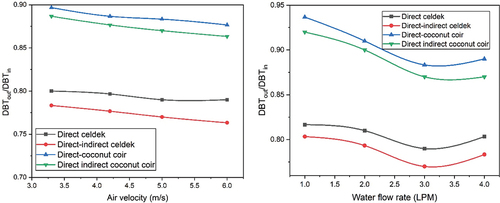
The combination of direct and indirect shows better results than the direct type. Sensible cooling occurs in the indirect cooler, and the air is cooled by extracting sensible energy from water without changing the absolute humidity of the air. When this air exits the indirect heat exchanger, its RH may increase slightly based on the exit temperature. This restricts the evaporation rate of water in the direct evaporative cooler when air advances to the next stage. The exit air from the indirect evaporative cooler enters the direct cooler (consisting of either celdek or coconut coir) packing, which evaporates, leading to a lower dry-bulb temperature. During the process, evaporated moisture deposits in the air and exit conditions are more humidified than in the inlet air. Here, the temperature reduction includes two components: one from the indirect cooler and the other from the direct evaporative cooler consisting of packing material. These two components are cumulatively added at the exit, resulting in a significant drop in DBT at the duct exit. When water evaporation was considered, it only occurred in the direct type. Hence, a minimum rise in air humidity with a maximum temperature change is observed, which is the main advantage of this type of indirect-direct evaporative cooler.
Furthermore, celdek packing has the edge over coconut coir packing in terms of temperature drop. A more uniform structure of the Celdek packing enhances the water-to-air interaction compared to the coconut coir. In addition, the water-holding capacity of the coconut coir was lower than that of the cellulose-based packing. Hence, the temperature reduction in the case of the coconut coir is less than that of commercially available celdek packing. However, owing to other advantages such as easy availability and easy replacement, as it is a biomass-based type, it is biodegradable and hence environmentally free, less costly, and hence economical, favouring the selection of coconut coir as an alternative packing material.
The figure also shows the variation in the DBT ratio with the water flow rate. As the water flow rate increased, the ΔDBT also increased. The temperature drops in both the indirect and direct coolers were enhanced when the flow rate was higher. Further, from the tested results, it is seen that when the flow rate is higher than 3 LPM, the performance deteriorates by showing an increase in exit DBT values. When the flow rate was too high, the residence time or interaction time decreased, which reduced the temperature drop. Hence, at 3 LPM, the lowest temperature ratio is noticeable.
3.2. Exit RH variation
The variation in the exit RH with air velocity is shown in . The exit RH increased as the air velocity increased. This is because of the evaporation of water and its deposition in the air that occurs in the direct evaporative cooler. In an indirect heat exchanger, only sensible heat exchange occurs, reducing the air temperature without changing the air-specific humidity. However, when it enters the packing media, the interaction with water causes water to evaporate because of the difference in the vapour pressure between warm air and cold water. As the air velocity increased, the evaporation rate increased, increasing the exit RH. On comparing the two packing materials, it is seen that the RH increase in celdek is higher than that in the coconut coir. This may be due to the higher wettability and water-holding capacity of the Celdek packing compared to the coconut coir. A coconut coir is brittle and cannot hold water for a long time. This hinders the evaporation of water; hence, the ratio is less than that of celdek packing.
Figure 5. Variation of RH ratio with the air velocity and water flow rates for different configurations.
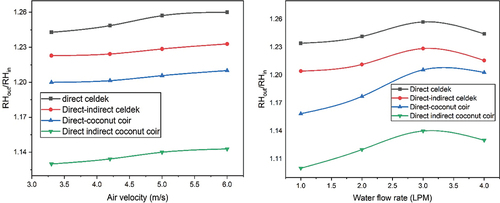
A comparison of the direct and indirect-direct methods revealed that the direct method shows a higher RH ratio. Initially, in the indirect cooler exit, RH increased slightly owing to sensible heat exchange. The air temperature decreased, which also slightly increased the exit RH. This reduces the capacity to hold moisture when it comes to the direct evaporative cooler, which results in appreciably lower RH values compared to the direct type.
In contrast, in the direct type, the entire evaporation occurs on the packing surface. Therefore, more water evaporation contributes to the increased value of the exit RH. Hence, it is seen that the RH ratio remains higher for this case compared to the indirect-direct type. Hence, the combination of indirect and direct methods yielded a lower RH ratio and a lower DBT ratio. This means that a significant temperature drop is achievable with a minimum increase in the absolute humidity of the air. A similar observation was also made for varying water flow rates, with 3 LPM showing the highest ratio and 1 LPM showing the least.
3.3. Wet bulb effectiveness
The wet-bulb effectiveness is the ratio of the temperature (DBT) between the inlet and exit to the temperature difference between the inlet DBT and inlet WBT. It can be seen that for all the tested conditions, it increased with the airflow rate. From the previous section, it can be seen that a higher temperature difference is observed for higher velocities. Hence, as the inlet WBT remained constant, higher air flow rates yielded a higher wet-bulb effectiveness. When the air velocity was increased, the heat exchange between the air and water was enhanced in the indirect evaporative cooler. In an indirect-direct evaporative cooler, air temperature initially decreases due the sensible energy transfer between air and water and later in the direct evaporative cooler, further drop in the temperature occurs due to the evaporation of water. As a result, a cumulatively higher temperature drop occurs at the exit, resulting in a higher wet-bulb effectiveness. A comparison between the two materials reveals that coconut coir shows lower performance than celdek filling. Celdek is structured packing arranged in a symmetrical matrix form. It allows proper communication between the two fluids, whereas the coconut coir is brittle, stiff, and possesses a reduced water retention capacity. The unsystematic arrangement of coconut fibres inside the mesh may also influence the interaction between air and water. Hence, the effectiveness was lower than that of Celdek. However, it has advantages such as lower cost, maintenance-free, biomass-based, higher life, and easy replacement, and coconut coir is a potential alternative candidate for evaporative coolers.
Variation with the water flow rate reveals that the effectiveness increases to an optimum flow rate of 3 LPM. A further increase in the flow rate reduced the effectiveness. When the flow rate is too low, the sensible heat transfer in the indirect evaporative cooler and the latent heat transfer in the direct evaporative cooler are very low. It accelerates as the flow rate increases and peaks at 3 LPM. When the flow rate is too high, a large mass of water passes through the indirect and direct coolers without much interaction with air. Hence, the temperature reduction in both types of coolers is reduced. A similar trend is seen when comparing the two materials as the variation in air velocity with the coconut shows lower performance than the Celdek packing, which is clearly understood from .
3.4. Pressure drop
As air needs to pass through both coolers, the pressure drop variation plays a significant role in the design because the minimum air velocity at the exit is within the limit specified by the ASHRAE standards. As the entry air velocity increases, ΔP generally increases. For any definite water flow rate, the resistance offered to the motion increased when the air velocity was increased. This increase in frictional resistance increased the pressure drop, as shown in . Coconut packing with an indirect-direct evaporative cooler showed the highest, whereas celdek packing showed the lowest. In both the celdek-based and coconut-coir-based indirect coolers, ΔP is the same as the same indirect heat exchanger used. Hence, it is understood that the coconut coir shows a higher drop in pressure than the Celdek packing. The coconut coir is randomly arranged, and because of the non-compactness of the arrangement, the air gap provided is less and inconsistent. This hinders air motion through the gaps inside the packing.
Figure 7. Pressure drop variation with the air velocity and water flow rates for different configurations.
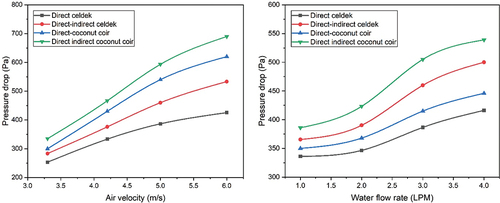
Hence, a slightly higher-pressure drop is observed. The influence of the change in water flow rate did not show appreciable ΔP values. However, when the water flow rate is too high, it is difficult for air to escape through the dense water layer; in other words, a slightly higher ΔP may be observed. On comparing the indirect with only direct, it can be seen that when two heat exchangers are used, ΔP will be higher. In the indirect heat exchanger, even though the fluids were non-mixed, a slightly higher-pressure drop was observed. When entering the direct type, this will be cumulatively added with the earlier, and hence, ΔP will be significant. However, when only direct is used, the air path travel is reduced with a lower disturbance in the path. Hence, the pressure drop is minimal. Slightly higher pumping power is required for the indirect-direct combination than the direct combination. However, the primary purpose of limiting the exit RH rise with increasing temperature drop could be achieved with a slightly higher penalty in terms of a slightly higher ΔP in the case of the indirect-direct type evaporative cooler.
3.5. Energy consumption
The energy consumption for the operation consists of the energy required for the blower to blow air, together with the energy consumed by the pump. The energy consumed by the pump was minimal and remained constant irrespective of the variation in the air velocity. The water flow rate was controlled using manually operated valves. Hence, it is the energy required by the blower that changes with the variation in air velocity.
As shown in , as the air velocity increased, the energy consumption also increased. When the air velocity increased from 3 m/s to 6 m/s, energy consumption increased by 33%, 37% 36% and 38% for the four different configurations colder-direct, celdek direct-indirect, coconut coir direct, and coconut coir direct – indirect respectively. This shows that a slightly higher energy is required for coconut coir than that of the celdek combination. Even though the energy consumed by the blower is very low at a lower inlet air velocity of 3 m/s, because the air has to pass through both heat exchangers before it is taken to the room, ΔP will be slightly higher than that of the single-stage evaporative cooler. As a result, the exit velocity is too low and may lie below the limit specified by the ASHRAE standards. Hence, the inlet air velocity is judiciously selected to fulfil the tradeoff between the energy consumed and the ΔP value to ensure that the required exit velocity is attained, which may lie within the limits specified by the ASHRAE standards. It was concluded that the combination of indirect and direct evaporative coolers can reduce the air exit temperature to a lower value than using only direct packing without increasing the exit RH, as in the former case. However, upon using the coconut coir as a packing material even though temperature depression is slightly lower as compared to celdek packing, it has advantages such as lower cost, maintenance-free, biomass-based, higher life, and easy replacement. Even though the energy consumption is marginally higher for coconut coir as compared to the celdek packing (about 1%), due to the above-mentioned advantages it can be a viable option for evaporative cooling in rural areas.
Commercially available cellulose based celdek packing is costly and may be unavailable in rural areas. Celdek packing costs USD 6 per square feet area, whereas coconut coir is one of the waste products of the coconut tree, is available at free of cost. Prolonged experiments conducted by using coconut coir as the packing material revealed that, after the continuous usage for 3 months, the exit air quality was not deteriorated showing its better performance as compared to celdek packing. If it is required to be replaced also, replacement will be very simple and doesn’t require any skilled operator as can be seen from . Further, as it is biodegradable, its disposal will not harm the environment and hence it is environmentally friendly. Even though the operating costs of the coconut coir are marginally higher by around 0.03 kWh (around 1%) compared to that of celdek for the same thermal comfort conditions as discussed in the above section, is compensated by the advantages as mentioned above. The increase in operational costs of coconut coir is found to be very small or negligible as compared with the fixed costs incurred by using the celdek packing for the evaporative cooler. Due to these advantages, it can be conveniently used in the evaporative coolers making the cooler as sustainable and economically viable, especially in rural areas. Hence using biomass-based coconut coir in a combination of indirect-direct evaporative cooler, a reasonable drop in air temperature could be achieved without a substantial increase in the exit humidity which is the main contribution of the present work to the knowledge of evaporative cooling.
4. Comparison with the literature results
The present work results are compared with the literature values, especially for multi-stage evaporative cooling systems. A combination of evaporative coolers and multi-stage coolers with different packing configurations was compared, as shown in . The results of the present work agree with the literature values, suggesting using coconut coir as an alternative packing material.
Table 4. Comparison of the present study with the available literature.
5. Conclusions
In the present work, the feasibility of a coconut coir for evaporative cooling was experimentally studied in an indirect-direct evaporative cooler. The performance of the system was compared with that of the direct type alone and with commercially available Celdek packing under similar operating conditions. The results are summarised as follows:
The performance of the indirect-direct evaporative cooler is better than the direct cooler alone in terms of reduced ΔDBT and lower ΔRH at the duct exit using both celdek and coconut coir packing.
It was found that for the indirect-direct combination using coconut, ΔDBT reduced by 3.2%, and ΔW increase was 3.6% less than the direct type when using the same packing.
The performance of the coconut coir-based packing was slightly inferior to that of the celdek packing. A reduction of 11.6 % in ΔDBT and 15.3% in wet bulb effectiveness have been observed for the coconut coir against celdek packing.
For the coconut coir packings, when the air velocity is increased from 3 m/s to 6 m/s, the change in DBT increased by 3.5%, whereas RH change increased by 2%. Similarly, when the flow rate increased from 1 LPM to 3 LPM, the corresponding parameters increased by 5.7% and 3.6%, respectively.
The optimum values of ΔDBT, ΔRH, and effectiveness were observed for the operating conditions of a water flow rate of 3 LPM and air velocity of 6 m/s for the coconut coir. These values are correspondingly 13.1%, 7.8%, and 19% lower than celdek packing.
When the air velocity was increased from 3.3 to 6 m/s, energy consumption increased by 51%, whereas the change in water flow rate had no significant impact on the energy required for the operation.
Future studies: The heat transfer rate in the indirect cooler can be enhanced by using various methods either by using nanofluids instead of pure water or novel concepts such as porous layer, and ultrasonic atomisation can be used to enhance the energy transfer rate. Similarly in direct evaporative coolers, alternative biomass materials such as palash, khus, palm and aspen fibres can be used and testing could be undertaken.
Disclosure statement
No potential conflict of interest was reported by the author(s).
Data availability statement
Data will be made available on reasonable request.
Additional information
Notes on contributors
Arunkumar HS
Arunkumar HS is an Assistant Professor in the Department of Mechanical and Industrial Engineering at Manipal Institute of Technology, MAHE, Manipal, India. His areas of interest include Thermal Power Engineering, Numerical Analysis, Renewable Energy Systems, Gas Turbine Cooling, Computational Fluid Dynamics, and Solar Energy.
Madhwesh N
Madhwesh N is Associate Professor in the Department of Mechanical and Industrial Engineering, Manipal Institute of Technology, Manipal Academy of Higher Education, Manipal, India. His research interests are Heat exchangers, Turbomachinery, Photovoltaic cooling and Solar energy
Shankar Shenoy
Mr Shankar Shenoy is Research Scholar in the Department of Mechanical and Industrial Engineering at Manipal Institute of Technology, Manipal, India.
Shiva Kumar
Dr Shiva Kumar completed Ph.D. from Visvesaraya Technological University, India in 2012 in the area of Internal Engine combustion. He is having teaching experience of around 22 years and industrial experience of 8 years. His areas of research interest include Engine combustion, alternative fuels, soft-computing techniques, CFD studies, nanofluids, refrigeration and air conditioning, desiccant techniques and evaporative cooling, etc. He has published 103 papers in reputed Scopus indexed international journals and 14 papers in International conferences.
References
- Abohorlu, D. P., S. Riffat, G. Gan, and D. Aydın. 2019. “Experimental Study of the Potential of Eucalyptus Fibres for Evaporative Cooling.” Renewable Energy 131:250–260. https://doi.org/10.1016/j.renene.2018.07.005.
- Ahmed, E. M., O. Abaas, M. Ahmed, and M. R. Ismail. 2011. “Performance Evaluation of Three Different Types of Local Evaporative Cooling Pads in Greenhouses in Sudan.” Saudi Journal of Biological Sciences 18 (1): 45–51. https://doi.org/10.1016/j.sjbs.2010.09.005.
- Al-Juwayhel, F., H. El-Dessouky, H. Ettouney, and M. Al-Qattan. 2004. “Experimental Evaluation of One, Two, and Three-Stage Evaporative Cooling Systems.” Heat Transfer Engineering 25 (6): 72–86. https://doi.org/10.1080/01457630490486292.
- Alklaibi, A. M. 2015. “Experimental and Theoretical Investigation of Internal Two-Stage Evaporative Cooler.” Energy Conversion and Management 95:140–148. https://doi.org/10.1016/j.enconman.2015.02.035.
- Aziz, R. A., N. F. Zamrud, and N. Rosli. 2018. “Comparison on Cooling Efficiency of Cooling Pad Materials for Evaporative Cooling System.” Journal of Modern Manufacturing Systems and Technology 1:61–68. https://doi.org/10.15282/jmmst.v1i1.199.
- De Antonellis, S., C. M. Joppolo, P. Liberati, S. Milani, and L. Molinaroli. 2016. “Experimental Analysis of a Cross Flow Indirect Evaporative Cooling System.” Energy and Buildings 121:130–138. https://doi.org/10.1016/j.enbuild.2016.03.076.
- Eldessouky, H. 2004. “Performance Analysis of Two-Stage Evaporative Coolers.” Journal of Chemical Engineering 102 (3): 255–266. https://doi.org/10.1016/j.cej.2004.01.036.
- Farmahini Farahani, M., G. Heidarinejad, and S. Delfani. 2010. “A Two-Stage System of Nocturnal Radiative and Indirect Evaporative Cooling for Conditions in Tehran.” Energy and Buildings 42 (11): 2131–2138. https://doi.org/10.1016/j.enbuild.2010.07.003.
- Franco, A., D. Valera, and A. Peña. 2014. “Energy Efficiency in Greenhouse Evaporative Cooling Techniques: Cooling Boxes versus Cellulose Pads.” Energies 7 (3): 1427–1447. https://doi.org/10.3390/en7031427.
- Gunhan, T., V. Demir, and A. K. Yagcioglu. 2007. “Evaluation of the Suitability of Some Local Materials as Cooling Pads.” Biosystems Engineering 96 (3): 369–377. https://doi.org/10.1016/j.biosystemseng.2006.12.001.
- Heidarinejad, G., M. Bozorgmehr, S. Delfani, and J. Esmaeelian. 2009. “Experimental Investigation of Two-Stage Indirect/Direct Evaporative Cooling System in Various Climatic Conditions.” Building and Environment 44 (10): 2073–2079. https://doi.org/10.1016/j.buildenv.2009.02.017.
- Heidarinejad, G., and S. Moshari. 2015. “Novel Modelling of an Indirect Evaporative Cooling System with Crossflow Configuration.” Energy and Buildings 92:351–362. https://doi.org/10.1016/j.enbuild.2015.01.034.
- Jain, J. K., and D. A. Hindoliya. 2011. “Experimental Performance of New Evaporative Cooling Pad Materials.” Sustainable Cities and Society 1 (4): 252–256. https://doi.org/10.1016/j.scs.2011.07.005.
- Kumar, S., G. Hariharan, M. Fayaz, and N. Kumar. 2023. “Experimental Investigation on Dehumidification Using a Solid Composite Bio Desiccant Internally Cooled Using Nanofluids for Building Cooling.” Buildings 13 (6): 1461. https://doi.org/10.3390/buildings13061461.
- Kumar, S., S. K. Reddy, and S. S. Salins. 2022. “Experimental Investigation on the Humidification Parameters of the Reciprocating Multistage Evaporative Cooler-A Novel Approach.” International Journal of Thermal Sciences 177:107539. https://doi.org/10.1016/j.ijthermalsci.2022.107539.
- Malli, A., H. R. Seyf, M. Layeghi, S. Sharifian, and H. Behravesh. 2011. “Investigating the Performance of Cellulosic Evaporative Cooling Pads.” Energy Conversion and Management 52 (7): 2598–2603. https://doi.org/10.1016/j.enconman.2010.12.015.
- Min, Y., Y. Chen, and H. Yang. 2022. “Investigation on Dynamic Behaviour of Condensation Heat Transfer in Indirective Evaporative Cooler.” Indoor and Built Environment 31 (8): 2024–2035. https://doi.org/10.1177/1420326X20944415.
- Mitz-Hernandez, E., M. Gijón-Rivera, and C. I. Rivera-Solorio. 2022. “Annual Thermal Performance Assessment of a Regenerative Evaporative Cooling System Under Different Climate Conditions in Mexico.” Indoor and Built Environment 31 (4): 988–1003. https://doi.org/10.1177/1420326X211045732.
- Mujahid Rafique, M., P. Gandhidasan, S. Rehman, and L. M. Al-Hadhrami. 2015. “A Review on Desiccant-Based Evaporative Cooling Systems.” Renewable and Sustainable Energy Reviews 45:145–159. https://doi.org/10.1016/j.rser.2015.01.051.
- Ndukwu, M. C., M. I. Ibeh, E. C. Ugwu, D. O. Igbojionu, A. A. Ahiakwo, and H. Wu. 2022. “Evaluating Coefficient of Performance and Rate of Moisture Loss of Some Biomass Humidifiers Materials with a Developed Simple Direct Stand-Alone Evaporative Cooling System for Farmers.” Energy Nexus 8:100146. https://doi.org/10.1016/j.nexus.2022.100146.
- Nie, J., S. Yuan, L. Fang, Q. Zhang, and D. Li. 2018. “Experimental Study on an Innovative Enthalpy Recovery Technology Based on Indirect Flash Evaporative Cooling.” Applied Thermal Engineering 129:22–30. https://doi.org/10.1016/j.applthermaleng.2017.09.139.
- Saleh, A., and M. A. Al-Nimr. 2008. “The Effectiveness of Multi-Stage Dehumidification—Humidification for Improving the Cooling Ability of Evaporative Air Conditioning.” Proceedings of the Institution of Mechanical Engineers, Part A: Journal of Power and Energy 223 (1): 11–20. https://doi.org/10.1243/09576509jpe656.
- Salins, S. S., S. S. Kumar, A. J. J. Thommana, V. C. Vincent, A. Tejero-González, and S. Kumar. 2023. “Performance Characterization of an Adaptive-Controlled Air Handling Unit to Achieve Thermal Comfort in Dubai Climate.” Energy 273:127186. https://doi.org/10.1016/j.energy.2023.127186.
- Shi, W., Y. Min, X. Ma, Y. Chen, and H. Yang. 2022. “Performance Evaluation of a Novel Plate-Type Porous Indirect Evaporative Cooling System: An Experimental Study.” Journal of Building Engineering 48:103898. https://doi.org/10.1016/j.jobe.2021.103898.
- Suranjan Salins, S., S. V. K. Reddy, and S. Kumar. 2021. “Experimental Investigation on the Use of Alternative Innovative Materials for Sustainable Cooling Applications.” International Journal of Sustainable Engineering 14 (5): 1207–1217. https://doi.org/10.1080/19397038.2021.1924894.
- Tejero-González, A., and A. Franco-Salas. 2021. “Optimal Operation of Evaporative Cooling Pads: A Review.” Renewable and Sustainable Energy Reviews 151:111632. https://doi.org/10.1016/j.rser.2021.111632.
- Tripathi, R. J., and D. Kumar. 2023. “Performance Assessment of Solar-Driven Indirect Evaporative Cooling with a Novel Wet Channel: An Experimental Study.” Journal of Building Engineering 78:107674. https://doi.org/10.1016/j.jobe.2023.107674.
- Xu, Z., Y. Xie, and Y. Xiao. 2017. “A Compact Packing Humidifier for the Micro Humid Air Turbine Cycle: Design Method and Experimental Evaluation.” Applied Thermal Engineering 125:727–734. https://doi.org/10.1016/j.applthermaleng.2017.07.031.
- Zamen, M., S. Soufari, and M. Amidpour. 2011. “Improvement of Solar Humidification-Dehumidification Desalination Using Multi-Stage Process.” Chemical Engineering Transactions 25:1091–1096. https://doi.org/10.3303/CET1125182.
- Zhou, Y., Z. Yan, Q. Dai, and Y. Yu. 2021. “Experimental and Numerical Evaluation of a Two-Stage Indirect/Thermoelectric Assisted Direct Evaporative Cooling System.” Energy Conversion and Management 248:114780. https://doi.org/10.1016/j.enconman.2021.114780.

